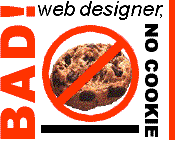|
|

(A couple of years ago, heated argument raged on the fight-censorship mailing list about whether web ratings could ever be a positive thing. In the middle of all this, I suggested, half-seriously, that a rating system that graded web pages based on technical criteria might not be a bad thing at all. Herein:)
| 0: | No animation on page |
| 1: | Small or single-loop animated GIF |
| 2: | Multiple endlessly-looping animated GIFs |
| 3: | Large animation requiring download of huge plugin |
| 4: | Use of <blink> tag |
| 0: | Readable page |
| 1: | Helvetica or small sizes used for body text |
| 2: | Partially-set colors in <body>, resulting in white-on-white text for some visitors |
| 3: | Fluorescent text and/or background |
| 4: | Bright busy background GIF, making text unreadable |
| 0: | No moving, shaking, singing, or dancing |
| 1: | Javascript rollovers in civilized colors |
| 2: | Constant cookie requests |
| 3: | Popup windows containing animated advertisements |
| 4: | Autoplaying sound files with no "off" button |
| 0: | No use of frames or tables |
| 1: | Tables, no hardcoded widths |
| 2: | Use of tables to create "left-hand index of death" with
hardcoded widths forcing horizontal scrolling |
| 3: | Simple frameset |
| 4: | Complex (2 or more deep) frameset |
| 0: | Actually tested on variety of browsers |
| 1: | Formal compliance with some known HTML standard |
| 2: | Weird proprietary HTML that nevertheless falls back gracefully on other browsers |
| 3: | Weird proprietary HTML that doesn't |
| 4: | "Standard? What standard? Like, this is anarchy, duuuude!" |
You get the idea. If I could tell a search engine to please ignore all pages that use <blink>, I'd be a happy woman.
A bit of background: The PICS standard, originally proposed as a content-neutral method of labeling web pages and since adopted by various authorities for censorship purposes, was a hotly-contested topic on the fight-censorship list in 1997.
The most popular PICS-based system, RSACi, is aimed at censoring "unsuitable" content, and does so with a 5-level scheme for each category. For example, a rating of 0 on the violence scale means "no violence", 1 means "injury to human being", 2 means "destruction of realistic objects", and so on. (If this sounds a little off as a description of web pages, it's not just you. RSACi is actually a rating system for video games, "repurposed" for the web.)
My view was this: PICS itself isn't a rating system; it's a standard that lets you set up a rating system in a standard way. You can use PICS for any kind of rating system, not just systems aimed at keeping [sex|violence|Nazism|Incorrect Ideas] out of the hands of kids, or at censoring them altogether. The problem arises when 1) someone uses the PICS standard to enable construction of a rating standard aimed at classifying the Bad Thoughts du Jour, and 2) a government or consortium of governments mandates adoption of this standard, directly or indirectly. When these two additional conditions are met, PICS becomes a tool for defacto censorship.
Since then, the thrust of PICS has changed and my views have shifted accordingly. I still think an open content-neutral structure for self-rating of web pages - along all sorts of axes, "suitability for children" being only one - would be useful. Think of what search engines could do, for example, if many pages carried a Library of Congress subject number. But the PICS consortium has, in the intervening two years, swung more and more toward the use of PICS solely for censorship, and this being the case, it's clear PICS is not that structure. Too bad - it was an interesting idea.